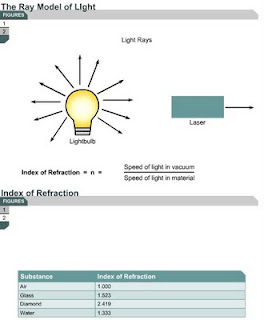Ray model of light
3.2.2 This page describes the properties of light rays.
When electromagnetic waves travel out from a source, they travel in straight lines. These straight lines pointing out from the source are called rays.
Think of light rays as narrow beams of light like those produced by lasers. In the vacuum of empty space, light travels continuously in a straight line at 300,000 kilometers per second. However, light travels at different, slower speeds through other materials like air, water, and glass. When a light ray called the incident ray, crosses the boundary from one material to another, some of the light energy in the ray will be reflected back. That is why you can see yourself in window glass. The light that is reflected back is called the reflected ray.
The light energy in the incident ray that is not reflected will enter the glass. The entering ray will be bent at an angle from its original path. This ray is called the refracted ray. How much the incident light ray is bent depends on the angle at which the incident ray strikes the surface of the glass and the different rates of speed at which light travels through the two substances.
The bending of light rays at the boundary of two substances is the reason why light rays are able to travel through an optical fiber even if the fiber curves in a circle.
The optical density of the glass determines how much the rays of light in the glass bends. Optical density refers to how much a light ray slows down when it passes through a substance. The greater the optical density of a material, the more it slows light down from its speed in a vacuum. The index of refraction is defined as the speed of light in vacuum divided by the speed of light in the medium. Therefore, the measure of the optical density of a material is the index of refraction of that material. A material with a large index of refraction is more optically dense and slows down more light than a material with a smaller index of refraction.
For a substance like glass, the Index of Refraction, or the optical density, can be made larger by adding chemicals to the glass. Making the glass very pure can make the index of refraction smaller. The next lessons will provide further information about reflection and refraction, and their relation to the design and function of optical fiber.
The Interactive Media Activity demonstrates how light travels.
The next page discusses reflection.
3.2.2 This page describes the properties of light rays.
When electromagnetic waves travel out from a source, they travel in straight lines. These straight lines pointing out from the source are called rays.
Think of light rays as narrow beams of light like those produced by lasers. In the vacuum of empty space, light travels continuously in a straight line at 300,000 kilometers per second. However, light travels at different, slower speeds through other materials like air, water, and glass. When a light ray called the incident ray, crosses the boundary from one material to another, some of the light energy in the ray will be reflected back. That is why you can see yourself in window glass. The light that is reflected back is called the reflected ray.
The light energy in the incident ray that is not reflected will enter the glass. The entering ray will be bent at an angle from its original path. This ray is called the refracted ray. How much the incident light ray is bent depends on the angle at which the incident ray strikes the surface of the glass and the different rates of speed at which light travels through the two substances.
The bending of light rays at the boundary of two substances is the reason why light rays are able to travel through an optical fiber even if the fiber curves in a circle.
The optical density of the glass determines how much the rays of light in the glass bends. Optical density refers to how much a light ray slows down when it passes through a substance. The greater the optical density of a material, the more it slows light down from its speed in a vacuum. The index of refraction is defined as the speed of light in vacuum divided by the speed of light in the medium. Therefore, the measure of the optical density of a material is the index of refraction of that material. A material with a large index of refraction is more optically dense and slows down more light than a material with a smaller index of refraction.
For a substance like glass, the Index of Refraction, or the optical density, can be made larger by adding chemicals to the glass. Making the glass very pure can make the index of refraction smaller. The next lessons will provide further information about reflection and refraction, and their relation to the design and function of optical fiber.
The Interactive Media Activity demonstrates how light travels.
The next page discusses reflection.

Comments
Post a Comment